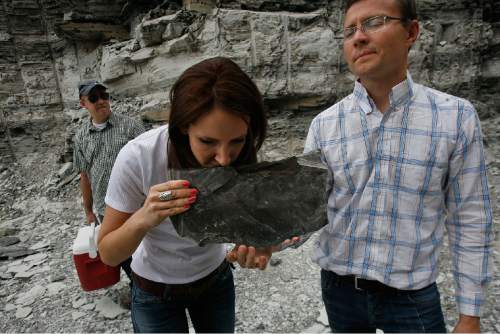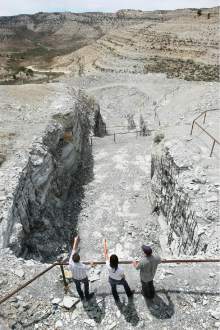This is an archived article that was published on sltrib.com in 2016, and information in the article may be outdated. It is provided only for personal research purposes and may not be reprinted.
A proposed oil-shale mine and processing plant would generate up to 23 million tons of spent shale, yet Enefit American Oil has not revealed how it intends to safely manage this waste, which would be in a chemically unstable state, liable to shed heavy metals and other contaminants.
That's one of many claims leveled at the Bureau of Land Management as it reviews Enefit's proposed utility corridor across public land in eastern Uintah County for moving power, oil, natural gas and water between a strip mine on private land south of the White River to existing lines several miles north.
Public comment closed this week on a draft Environmental Impact Statement for the corridor project. Fourteen environmental groups submitted joint comments, insisting the federal agency reject Enefit's right-of-way application, which they say would subsidize a project that would exact an unacceptable toll on the climate, the landscape and water resources.
"They have to assess if the project is in the public interest. Absent an analysis of the impacts of the 50,000-barrel-a-day processing plant and the 9,000-acre strip mine the project will enable, it's impossible to determine whether granting the right of way is or isn't in the public interest," said Anne Mariah Tapp, energy program director for the Grand Canyon Trust. "The BLM is obligated to analyze those impacts which they failed to do."
But the company says there are good reasons why it can't spell out its operations yet. Final design for the mine and retort plant, and therefore its impacts, depend on whether Enefit wins the right of way, which is not necessary for Enefit's plans to produce 50,000 barrels a day here, according to Enefit CEO Rikki Hrenko-Browning.
"This decision is only on the utility corridor. BLM has no jurisdiction on the activities on private property," she said. "The oil-shale project will proceed regardless of their decision on the right of way. There are alternatives through which we can truck water in and oil out."
Without the right of way, the company would build a power plant on-site and develop alternative sources of natural gas to fire its operations.
"[BLM's] recommendation to grant the right of way is very much in the public interest. The corridor has a much lower environmental impact" than operating the mine without the corridor, Hrenko-Browning said.
Enefit is one of two projects in the Uinta Basin vying to become the nation's first commercial oil-shale mine, which would tap Utah's vast reserves of the immature hydrocarbon known as kerogen. Both enjoy support from local leaders who see oil shale as a way to secure the basin's economic future and provide well-paying jobs.
Enefit's utility corridor would include 19 miles of water supply pipeline, 8 miles of natural gas supply pipeline, 10 miles of oil-product line, 30 miles of single or dual overhead 138-kilovolt H-frame power lines, and upgrades to 5 miles of Dragon Road.
In its official comments, the state simply said mining is essential to the nation's "economic and physical well-being" and urged BLM to award the right of way.
In scoping comments last year, however, state officials had voiced concerns about the project disturbing the bed of the White River, which is vital habitat for endangered fish species that the officials would like to see recovered so they can be removed from federal protection.
In response, Enefit officials said they planned to tunnel under the river and construction would not affect the riverbed.
Public discussion on oil-shale development has focus heavily on the industry's carbon emissions, surface mining and need for water. In their 78 pages of comments, environmental groups hammered all those points, but put special focus on the millions of tons of spent ore that would come out of Enefit's "retort" plant.
Enefit is a subsidiary of the state-owned Estonian firm Eesti Energia, which has pioneered extracting kerogen from crushed rock and converting it to oil. The company's Enefit280 technology subjects the ore to intense heat to squeeze a barrel of oil from 1.5 to 2 tons of shale.
The company intends to return spent ore to the pit from which it was mined.
But environmentalists say the ore expands while it is processed, so it might not all fit in the mine cavity, and officials have no way of knowing whether this cavity would contain any contaminants that might leach off the ore.
"Oil shale is stable rock. Once you convert it, you have all those heavy metals and hydricarbons. It changes the characteristics of the waste in a way that is toxic," said Rob Dubuc, an attorney with Western Resource Advocates.
The potential volume of Enefit's spent ore would be huge, exceeding Utah's annual production of coal, but the groups' comments exaggerate the impact of this waste stream, Hrenko-Browning said. The ore does expand during processing, but that's only because it is crushed.
"The weight decreases but there is a minor volumetric increase. It's not 30 percent" as environmentalists contend, Hrenko said. "The material will still be backfilled into the mining void and reclaimed as we proceed. It is officially categorized as not hazardous waste. We would still have to move forward with multiple permits."
Once they know whether they can build a utility corridor on public land, company officials will finalize their mining, processing and reclamation plans, which would be submitted to the state Division of Oil, Gas and Mining and environmental-quality agencies for review.
Back home in Estonia, a tiny country on the Baltic Sea, oil-shale operations have created a "phenols marshland" that poses an ever-present threat to the environment, according to Silvia Lotman, chief executive of the conservation group Estonian Fund for Nature.
"Rain washes chemicals from these waste piles into the landscape and water. What will happen to Utah and to communities downstream if Enefit's waste harms the upper basin of the Colorado River watershed?" she wrote in a June 12 op-ed. "In the area where oil shale is mined in Estonia, there used to be three layers of groundwater suitable for human consumption. The oil-shale industry has permanently destroyed two of these layers."
Oil shale has been mined for a century in Estonia, where waste piles, known as "the Estonian Alps," have been rigged with rope tows in winter for skiers and are visible from space.
The waste referenced in Lotman's piece is not associated with Eesti Energia's operations, but with two private companies, according to Hrenko-Browning.
"Their environmental impacts are much different than ours. She has lumped every company together," Hrenko-Browning said. "I would hate for the public to assume those impacts are what we're anticipating in Utah. We are dedicated to developing the project in the most socially and environmentally responsible manner."
But for many environmental groups, responsible development means leaving Utah's vast underground ocean of oil shale where it is.
bmaffly@sltrib.com Twitter: @brianmaffly





